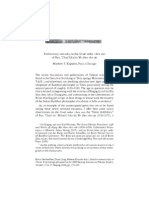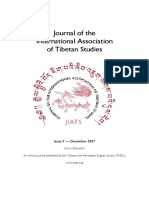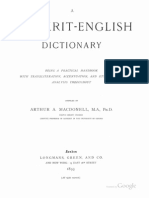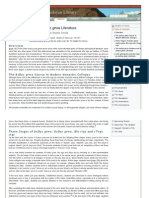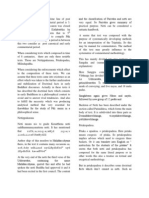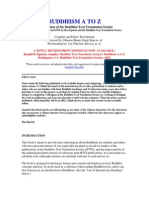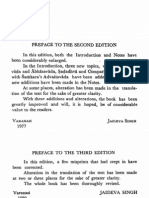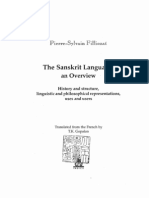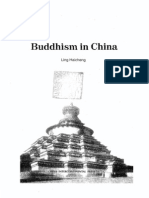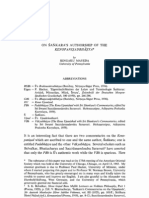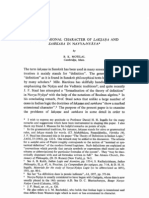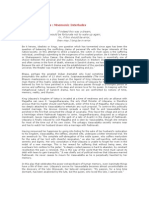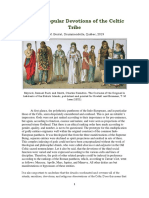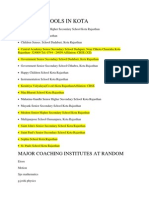Rtsod-Pa - The Monachal Disputations in Tibet
Rtsod-Pa - The Monachal Disputations in Tibet
Uploaded by
cha072Copyright:
Available Formats
Rtsod-Pa - The Monachal Disputations in Tibet
Rtsod-Pa - The Monachal Disputations in Tibet
Uploaded by
cha072Original Description:
Copyright
Available Formats
Share this document
Did you find this document useful?
Is this content inappropriate?
Copyright:
Available Formats
Rtsod-Pa - The Monachal Disputations in Tibet
Rtsod-Pa - The Monachal Disputations in Tibet
Uploaded by
cha072Copyright:
Available Formats
RTSOD-PA: THE MONACHAL DISPUTATIONS IN TIBET by
F. SIERKSMA
Leiden
In the first part of this article the institution of the Tibetan monachal debates will be described as it was remembered by an informant who daily has taken part in these debates over a period of eleven years. He was asked to write down everything he remembered in my presence, that is everything with the exception of the strictly logical and metaphysical aspects. He cooperated whole-heartedly because he wanted "to be useful" and especially because he obviously enjoyed the memory of the debates. As a matter of fact, this has been the only topic which he visibly loved to discuss. His notes were written in the Tibetan language. Since the writer cannot speak this language and since his knowledge of this language in its printed form is rather limited, we discussed the notes in English, liberal use being made of Tibetan-English and English-Tibetan dictionaries. In order to explain the expressions used by the debaters he used to give simple examples of logical reasoning. Among his favourite topics were the question, whether the fact that a scholar has read many books (we both have!) also implies that he is a good man, and the question whether there is an after-life or not. Sometimes we staged a debate with much gusto, imitating the speech and behaviour of debating monks. The informant is a Gelugpa (dGe-lugs-pa) "incarnation" from Khams who came to Lhasa when he was ten years old. After he had taken his doctor's degree, the degree of dge-b~es, he studied the theory (not the practice) of esoterical tantrism, skags, and also passed the final examination in this field of study. It goes without saying that the information which is presented here has a limited value. It should be amplified and corrected by other data given by other informants to other and more competent students. It seemed useful, however, to make an inventory of a qualified and well-known Tibetan scholar's knowledge of the subject, because little or nothing has been published on this subject. Some conclusions may be drawn from it with respect to the present state of learning in Tibet, the present scholarly attitude towards debating etc. As far as the writer of this article is con-
rtsod-pa: THE MONACHAL DISPUTATIONS
IN TIBET
131
cerned it should be explained why the logical, theological and philosophical aspects of the debates have been neglected. As an anthropologist he is interested in the history and structure of Tibetan culture and - be it conceded - not extraordinarily interested in logical and metaphysical matters of the kind that were so near to the heart of the informant. This does not imply, of course, that we did not discuss such matters. But having read this article the reader will see its objectives and understand that it has no logical and philological pretentions. With respect to the Tibetan words and expressions it should be stressed that they have been transcribed exactly as they were taken down by the informant. The Sanskrit equivalents have been kindly supplied by prof. dr. J. W. de Jong. After the first draft of this article had been finished, he drew my attention to the articles of Vostrikov and Obermiller. For the sake of comparison and also as an introduction a short synthesis of Obermiller's article may be given here. The work he describes is a manual (yig-cha) for the study of the Abhisamaydlam.kdra in the monastic schools. Like all the manuals of this kind, it is written according to a special plan, the analysis (mtha.hdpyod) always consisting of three parts: dgag-g~ag-spah-gsum. 1) dgag means g~an-lugs dgag-pa, Skt. para-mata-prati.sedha, the refutation of the opinions of others regarding the subject in question; 2) g~ag is rat~-lugs g~ag-pa, Skt. sva-mata-sthdpand, the establishment of the author's own point of view, encompassing a definition of the subject, an indication of its varieties etc. ; 3) spa~ is the abbreviation of rtsod-spa~, Skt. vivddaprah~.na, the refutations of the objections of opponents which are or may be directed against the points established by the author. The first and the third part of such an investigation are written in the form of a controversy, thus forming the patterns of the disputes held in the monastic schools (chos-grva). Obermiller does not indicate the texts in which he found the Sanskrit equivalents. Finally, mention should be made of Wayman's valuable article on Asafiga's rules of debate (Wayman, 1958).
When a monk has learned to read and write, he studies the well-known "five higher subjects" and learns the relevant texts by heart, blo-la bzuhba. The teacher explains the books, dpe-cha "khrid-pa, and also hears the lessons. But debating is considered at least as important a method of schooling. In our conversations it became clear that it is the most important method. It is called rtsod-pa rtsod-pa, the first word being a noun,
132
r. SIERKSMA
the second a verb. According to Jaschke the meaning of the noun is dispute, contention, quarrel, disputation, while the meaning of the verb is 1) to contend, to fight with arms, 2) to dispute, to debate, to wrangle. The noun is the translation of Skt. vdda, a philosophical disputation. Rtsod-pa may be used when many pairs of monks are debating simultaneously, when only two monks are debating, and even when one monk alone is mentally preparing himself for a disputation. When two monks are debating and bystanders, e.g. the members of a college, are listening, the debate may be called dam-bca', Skt. pratijgd, a proposition or thesis in logic. The informant used exactly the same two words when asked to translate the Tibetan noun. This was a rare occurrence, since he has no knowledge of Sanskrit and sometimes even failed to give a translation of Tibetan words and expressions. The purpose of the debates is to dispel wrong opinions, log-rtog sel-ba. The informant preferred "wrong opinions" to "heresies", giving examples of a logical or physical nature. This emphasis on general and rather formal scholarship is characteristic of the Gelugpa. With respect to the monachal disputations Stein even speaks of "l'rtat sclrros6 de cet exercice". Nevertheless, without being asked my informant repeatedly stressed that debating and scholarship should lead to salvation and that consequently a virtuous, pious and very sober life is required, "like Milarepa" as he put it. In this respect he mentioned the religious ceremonies that precede the debates in the morning and in the afternoon. During these ceremonies the monk should be aware of the meaning of the religious truths. Without these ceremonies and without a pious life the debates are "only words", he said. He evidently felt the dangers of formalism. Class-mates, who are often each other's opponents of course, are called 'dzin-grva gcig-pa, the (pupils) of one form, since the first word means form or year of studies. The monks who are learning to debate are called mtshan ~id-pa, the students of the faculty of logic, or dpe-cha-ba, the men of books. Since the knowledge of books is highly valued, the last word clearly sets them apart as an 61ite from the large majority of monks who do not study. Their disputations are usually held in the open air in winter as well as in summer. Both school and school-ground are called chos-ra, which is evidently a partly phonetical rendering of chos-grva. Here and there a tree is standing in the school-ground. The monks go to school three times a day, at about nine o'clock in the morning to the $og-chos (in the dictionaries only ~ogs is found, not ~og), at noon to the ~in-chos, and about four o'clock in the afternoon to the dgotis-po'i chos-grva, which sometimes may last until late into the night, that is "if you like to debate",
rtsod-pa:
THE MONACHAL DISPUTATIONS IN TIBET
133
as the informant said. Sometimes monks are debating from seven o'clock in the evening till seven o'clock in the morning. This nocturnal debate is called mtshan-phud dam-bca'. This may be translated as a debate of a (completely) spent night or a debate which takes the (whole) night. When m a n y people, e.g. all the monks of one college, gather to listen to a disputation, this is called a dam-bca' chen-mo. A student may also make a kind of debating tour, dam-bca' bskor-ba. He then goes to the different quarters and colleges of the monastery where for m a n y hours he has to answer the questions of the m a n y monks who one after another put his knowledge to the test. The audience is called rtsod-dpah, the witnesses of the debate, which might be understood in a rather juridical sense. The informant said that some monks m a y debate for five years, others for thirty years before they pass their final examination. The examinations also take the form of debates. The informant knew three kinds of examiners, mtshan ~abs-pa, gir-pa chos-rje, byad-rtse chosrje. He only told that the rntshan 5abs-pa are "the men who debate with the Dalai L a m a " . When a student has passed his final examination, he is a dge-b2es. There are different sorts of dge-bges. The informant mentioned the glih-bsre, the rta ra ma pa, and the gser-khri dge-b2es as ranking below the tshogs rams-pa and, the highest of them all, the lha rams-pa. The dge-b~es bka'-sgyur dam-bca' is a preliminary examination after which the abbot tells each student for which kind of dge-bJes-degree he has to p r e p a r e . It is rather a shame when the abbot tells a student, that he may become a lha rams-pa, if he works very hard. Such a student is called a ma-~es-pa. J~ischke translates this as "untrue", but since the informant stressed the word " m a y " very much and since in logic ma-hes-pa is the translation of Skt. anaik~ntika, i.e. an uncertain reason, it may be assumed that also in this case the word means "uncertain". Only the tshogsrams-pa and the lha-rams-pa are sent to Lhasa to pass their final examination "before the Tibetan government", as my informant put it. The sixteen lha-rams-pa are a selected 6lite of prize-winners - the informant was one of them in his time and won the fifth prize - who have to spend several very long days debating in the presence of the Dalai Lama. This is a real examination, rtsod-rgyugs, and not a formality. In the year when the informant became a lha-rams-pa, one of the sixteen scholars was sent away because he could not stand the test. When a m o n k has become a dge-b2es, he has finished his college career and debates only when he wants to. On special occasions he m a y be appointed to rise from the assembly and to debate with a colleague. This kind of debate is therefore called tshogsla~s. Das writes in his dictionary that on such an occasion the two schol-
134
F. SIERKSMA
ars "recite a religious discourse". This was firmly denied by my informant. He told that he knew from experience that a tshog-lahs is a real debate, a real rtsod-pa, except for the fact that both debaters are standing and that they are wearing their yellow robes and yellow "helmets". Sch~ifer e.g. has described a tshog-la~s (Schafer, 1952, 134). Usually the debate is a game of asking questions and giving answers, rtags-gsal gtoh-ba and lan brgyab-pa. Rtags is Skt. li~ga, logical mark. According to the informant rtags means sign or token and gsal is the predicate in grammar and in logic - subjects I must leave to the experts - but he insisted that rtags-gsal "means almost exactly the same as rtsod-pa". When questioned further, he stated that rtags-gsal is the specific word denoting the monachal disputation and that rtsod-pa may apply to any kind of quarrel, if this is true, the aggressive meaning of rtsod-pa, which is stressed by Jfischke, is as surprising as the fact that the informant himself always used the word rtsod-pa. The debate may also proceed along the lines of thesis and antithesis. To put forward one's own thesis is called rah-lugs b~ag-pa, to destruct the thesis of the opponent g~an-lugs 'gag-pa, while rtsod-pa spoh-ba means to refute the argumentation. When it was pointed out to him that according to Stein this last expression means "abandonner (sans doute: surmonter) la querelle" (Stein, 1962, 131), the informant denied this. Stein writes that the course of the disputations comes very near to our succession of thesis, antithesis and synthesis. One does not get this impression from Obermiller's article (Obermiller, 1932, 3), but again this must be left to the experts. From the information given by the informant I got the personal impression that attack and defence and therefore victory is the centre of the debates. Again and again being "very much ashamed" was stressed by him, when he mentioned the fact that one of the debaters failed in one way or another. This is strongly confirmed by the behaviour of debaters and bystanders, which will be discussed later on. The debater who is asking questions is called sha-rgol. According to J~ischke the meaning of this word is "he who begins a quarrel, the aggressor, assailor, both in war and in common life, e.g. in court". He therefore considers the translation "plaintiff" not quite adequate. As with rtsod-pa the question may be asked whether this word as a translation of a neutral Sanskrit terminus technicus - rgol is Skt. vddin - originally and maybe even in later times did or did not keep its aggressive connotations. It will be seen that his behaviour is still very aggressive. He may also be called rtags-gsal gtoh-mkhan. On the other hand, the monk who has to answer the questions is called phyi-rgol, which means according to Jaschke "he
rtsod-pa:
THE MONACHAL DISPUTATIONS IN TIBET
135
who is intent on defending himself against the attacks and accusations of the opponent by surpassing him in abusive language and especially by having recourse to witchcraft". Again the question of the aggressive connotation of the word phyi-rgol seems to be a legitimate one. In the monachal disputations the phyi-rgol is sitting and does not behave in an aggressive way, but the debaters may change parts and in that case the quietly sitting phyi-rgol becomes an aggressive sha-rgol. Another name of the debater who has to answer the questions is dam-bca'-ba. Before the sha-rgol asks his first question, the phyi-rgol takes off his head-gear and then the sha-rgol says: Dhi.h ji-ltar chos-'chad. This may be translated as "dhi.h, it will be explained in accordance with the doctrine". The first word of the expression is pars pro toto of the mantric formula of the bodhisattva of transcendent wisdom 'Jam-dpal (Mafiju~ri): ah ra pa tsa na dhi.h. By pronouncing these words the debate is placed inside the sphere of religious thought as well as action. (Further on the debate as a part of the way to salvation will be discussed). The theme of the disputation is called chos-can. J~ischke as well as Das translate this as "pious" but this was firmly denied by my informant. According to him "pious" is chos seres-can, whereas chos-can has the meaning "all the things that can be known" or "everything which pertains to religious knowledge". Professor de Jong, however, kindly referred to Stcherbatsky, who in his Buddhist Logic (II, 87, n. 6) states that chos-can is Skt. dharmin, i.e., "the possessor of the quality", the subject of the inference. The reinterpretation of the informant is rather interesting. Four expressions are most commonly used by the debaters: fin- par 'clod or simply "clod, which means "yes", ma- fin-par 'clod, which means "no", ci-phyir (Vostrikov: ci'i-phyir), which means "why?", khyab, which means "it is adequate", ma-khyab or khyab-pa ma-byuh, which means "it is inadequate", and rtags ma-grub, which means "evidence does not exist". These translations are the results of the joint efforts of my informant and me, but some of them prove to be inadequate. The exact meaning of these expressions, all of them parts of a debate along strictly syllogistic lines, is discussed by Vostrikov (1935, 60). It should be said, however, that the informant tried to explain the syllogistic debate to me and that I as a result of philosophical training in younger days had a fair idea of the syllogistic pattern, but in this respect linguistic barriers proved to be too high and being interested in other things we dropped the matter when we were very near our goal. One of my notes reads: "It might be, that khyab-pa has the meaning: 'your general thesis (the major of our Western logic) is true'" In order to prove his point a debater may quote a passage from an
136
r. SIERKSMA
authoritative book, lu~ 'dren-pa, which was first written by the informant lu~ dran-pa and then lu~-dra~s-pa. According to J~ischke lu~ is "a religious authority", but this was denied by the informant. He insisted that the meaning of this word is "a passage in a religious book". Since lu~ is Skt. ~gama, sacred scriptures, he is right, though neither of us knew the Sanskrit equivalent at the time. When a debater explains a passage word after word, discussing grammatical as well as theological and philosophical problems, this is called lug-don b~ag-pa, to put the meaning of a passage in order, to explain a passage systematically. A debater who sticks to his opinions is a 'dzin-mtshams dam-po, a man who tenaciously holds on to the demarcation. It is possible that there is a connection with logic here, but it may also have the meaning: a man who is holding his own tenaciously. I have been unable to find the exact meaning. When the disputant gives a correct answer it is said lan yag-po rgyabso~, lie has given a good answer. When he gives a wrong answer, people may say khas-len ~or-ba red, the khas-len has fallen. Khas-Ien seems to be a terminus technicus in logic. I got the impression that it refers to the argumentation of the disputant. At any rate I could not find a direct connection with the meanings of khas-len-pa given by J/ischke. It is curious however, that both dam bca'-ba and khas len-pa refer to the sitting disputant and have as their first meaning "to promise". When the disputant has to revoke a statement or argument, this is called khas-len slog-pa. When the disputant succeeds in squelching the opponent, it is said that rtags-gsal bcad, he has cut the disputation. In that case the debate stops, rtags-gsal chad, the opponent is very ashamed, ~o-tsha-ba, and has to change the subject, rtags-gsal spo-ba. When the opponent has been proved wrong, one may also say rtags-gsal bta~ ma thub-pa red, he has not been able to debate, but when the opponent's performance is a success, people say rtags-gsal tsha-po gto~-gi dug, which may be translated as, he has debated hotly, or sgrub-byed tsha-po gto~-gi 'dug. Sgrub byed is Skt. sddhana, proof. The expression may therefore be translated as: he has given hot evidence. With respect to tsha-po I remembered that in a passage in "The Blue Annals", which I regrettably have been unable to find again, a good debater is called a man possessed of a hot doctrine. The informant did not know this expression. He was of the opinion that tshapo means hot, but he did not feel that it had any aggressive connotations. This is surprising, because it will be seen that "hot", i.e. aggressive talk is a characteristic element of Tibetan culture. The word tsha-po is also used when the disputant has scored a good mark. Then people say lan tsha-po brgyab-gi 'dug or fan tsha-po brgyab, he has given a hot answer.
rtsod-pa: THE
MONACHAL DISPUTATIONS IN TIBET
137
When the st~a-rgol, the opponent, puts his first question, his right hand is held above his right shoulder - a little above his head - and his left hand is stretched forward, its palm being turned upward. Then he strikes the palm of the left hand hard with the palm of his right hand and immediately after that he crosses his arms before his breast. Then he holds his right hand above his right shoulder with fingers pointing upwards, but now he stretches his left arm backward with the palm of the hand turned outward. When the informant was standing in this position, I got the impression that with his left hand he was pushing away or shutting out something. The impression proved to be correct. When asked about a possible meaning of this posture, he told that the gesture of the left hand means hen-soh-gi skye-sgo gcod-pa. The first two words should of course be read ban-sob, Skt. apdya, evil state. There are three evil states, one of them being helt. The informant usually talked about hell when ban-sob was mentioned. He explained that "hen-soli is same as dmyal-ba". Although afterwards he was aware that dmyal-ba, which generally means hell, is "only one of the three hells" according to him one may translate the whole expression as: to close the door of birth in hell Thus at the beginning of a disputation the opponent shuts the door of hell with a sharp clap of his hands. The informant even went so far as to explain that by debating and living in accordance with the precepts of religion one can close the door of hell with respect to the next rebirth. Therefore the uplifted right hand means that-par 'khrid-pa, to lead to salvation. Both expressions point to the essential importance of the debates. The behaviour of the opponent is very aggressive. It has been described by m a n y travellers. Tafel's description is especially noteworthy, not only because he is such a reliable explorer and observer, but also because the s~a-rgol, whose behaviour he has seen and described, was a unique person. Nur eine dunkelrote, mittelgrosse M6nchgestalt, ein barh~iuptiger Priester, mit goldgestickter Pulostoffweste, violettroter Toga und gleichfarbigen Faltenrock schritt lebhaft hin und her und zitierte mit schallender Stimme Texte und Exegesen und stellte Fragen an die scheu dasitzenden Kandidaten. Bei jedem Stichwort schlug er laut klatschend mit der Rechten in seine eigene ausgestreckte Linke, dasses weithin durch die Tempelhallen schallte und auch mit den Ftissen stampfte er dasses drfhnte; denn es ist alte lamaistische Lehre, dass durch das H/indeklatschen die b6sen Geister der drei Welten zusammenschrecken mtissen und dass durch das Stampfen der Ftisse der Diskutierenden die Pforten der H611e sich 6ffnen sollen. Gab einer der Kandidaten eine falsche Antwort, so verfiel er sofort in einer/irgerlichen Ton, hielt dem Nichtskfrmer den Mund zu, verspottete ihn, und einmal schlug er gar zum Hohn mit seinem Bein ein Rad tiber den Kopf eines der Unglticklichen, so dass aUe Zuschauer den
138
F. SIERKSMA
Ernst vergassen und hellauf hinauslachten. Der lebhafte Examinator mit dem kleinen feingeschwungenen Schnurb~rtehen in der Mitte der hohen Priester war der Dalai Lama in h6chsteigener Person. (Tafel, 1914, II, 89) This "Imponierverhalten" - to borrow an apt term from animal psychology - reminds one of the time when chess-players were allowed to make a move in such a way that the piece came crashing downwards. When the 13th Dalai Lama behaves in the way described by Tafel, it is easily understood that the behaviour of common monks will be in proportion. Before the nose of the phyi-rgol they clap their hands, lag-pa brtab(?)-pa. With respect to brtab my attention was drawn to rdebs-pa, pf. brdab. The informant agreed. It therefore should be brdab. According to J/ischke clapping one's hands is chug-chug byed-pa, but this, the informant told me, means only "to pat, to tap (a man's shoulder or a horse's neck softly)" as he put it. Clapping one's hands in a Tibetan disputation is always very hard and loud. Only high dignitaries snap their fingers, se-gol byed-pa, as a sign of contempt and scorn, but as Tafel has shown, even the highest dignitary may refrain from this dignified behaviour. The debaters take off the upper part of their monk's habit, which they drape around the waist, because they are thus able to clap their hands more loudly. The informant told, that as a result he had sore cracks in his hands in wintertime, but that he "did not feel the cold", because he "had to think hard". Stamping one's feet is called rkah-pa brdab-pa. When the opponent grasps the shoulders of the disputant and shakes them, this is called krugs-krugs bta&ba. With respect to the orthography of the word krugs I expressed some slight doubt and drew the informant's attention to the verbs dkrugpa and sprug-pa. He changed his mind twice and finally decided for the second verb. Much later he told me about shouting, making p f f f sounds, disdainful gestures and other forms of aggressive "Imponierverhalten", which are aU called dma' 'bab-pa, to humiliate. Verbal behaviour is also aggressive, sharp and loud. The opponent may shout ~on a ~on a, listen, yes, listen, yes. The aah-sound is extremely short and sharp. When the disputant, the phyi-rgol, hesitates, the opponent shouts, clapping his hands loudly, khyer, khyer, which was literally translated by the informant: "bring, bring". He was unable to give any explanation. When the tentative supposition was made that there might be a connection with khyer-la gog, which according to J/ischke means "bring me (word), let me know", the informant could neither deny nor confirm this. When, on the other hand, the opponent hesitates, the disputant shouts da thon, now give! It is most probable that this means: give proof now. When a wrong answer is given or a wrong statement
rtsod-pa:
THE MONACHAL DISPUTATIONS IN TIBET
139
the opponent shouts dhos-'gal tsha, you violate the truth, tsha. The informant did not know the meaning of this last word. He only said in his English which is even worse than mine: "Tsha means like you are wrong". Then he wrote down the words: "tsha is 'gal-ba is wrong". According to J~ischke tsha may be the same as tsha-ba, hot. The informant did not see any connection. Maybe there is no connection at all. Maybe the word had a defying meaning formerly: be hot! When a debater has been proved wrong, his opponent may hit the palm or the back of his left hand with the back of his right hand and say in a hissing voice tsha tsha. This is called tsha brgyab-pa. Practising tsha brgyab-pa one does not fail to realise that the back of the hand is rather sensitive and very soon becomes painfully hot. Whichever the lost meaning of tsha may be, it certainly is very aggressive and I am therefore inclined to connect it with the Tibetan "hot mouth" which will be discussed further on. Another way of expressing one's scorn is making a scornful gesture with the left fist which grasps the lump of the rosary and saying 'kor-gsum dhos' gal-du sob. This expression, in which 'kor most probably must be 'khor, means according to the informant: " y o u have not been able to do the following three things, 1) rtags pha-rol-pos khas-blahs, 2) khyab-pa rah-lugs-la grub, 3) dam-bca'-la tshadmas gnod". From the informant's explanation it appeared to be rather certain that this expression applies to the syllogistic reasoning with its three phases of thoughts and its three requirements (tshul gsum-po, Skt. trirf~pa). I refer therefore to the article of Obermiller, which has been cited in the introduction, and to Stcherbatsky's Buddhist Logic (I, 355). The matter must be left to the experts. In a very general way the expression itself may be translated as: the whole science of logic has been contradicted, violated. When they have finished the debaters say "thank you" in the usual way, thugs-rje-che, or ha-la blo-skyed yag-po byuh, I have received a good increase of understanding, when one translates it more or less literally. The part played by the audience is the same as in other countries when two people quarrel. It is interesting to note that as long as the debaters perform well the public cannot be heard. But as soon as the debate does not proceed smoothly those present make their presence felt. When the disputant hesitates the bystanding monks - if there are laymen present they cannot understand the debate - shout in a deep voice lan rgyob, give answer. The word lan is drawn out, rising in pith and volume. Even shouted by only one deep and throaty voice it sounded rather threatening to me and I could well understand the informant when he told that it had made him very nervous when he started his career as a debater. When
140
F. SIERKSMA
the disputant fails to give a reply the audience laughs loudly and shouts tsha tsha or aah aah. Making this aah sound is called 'arja rgyab-pa. After some months the informant substituted cha for ja, telling me that eha means "many". He was very hesitant, however, and it was certainly not the first time that he could not make up his mind. If 'ar is an onomatopoeia, then is seems plausible that cha simply means voice. If the opponent fails and some of the bystanding monks are of the opinion that they can perform better, they walk up to him and push him aside with their hands and shoulders, sbidljagsrgyab-pa. According to the informant this means "to push", but after a few silent moments he added in a musing tone "like a thief". This is rather interesting. It became certain that by thief he meant a robber and it therefore may be asked whether there is a connection withjag-pa, which according to Das means "one who terrifies by shouts and gestures, robber". (Much later the informant himself decided for jag-pa.) The monachal disputations present us with a picture of aggressive behaviour and speech that may in some respect be called almost violent. This, however, was at first firmly denied by my informant. We had many and long conversations on this subject. In the course of two and a half years I have got the strong suspicion that with respect to his own life, as well as to Tibetan culture he is a man whose mind is characterized by strong repression in the psychoanalytical sense of this word (Glover, 1949, 70 ft.). The massive disturbances o f m e m o r y o f w h i c h Glover speaks were sometimes very evident. Besides this he sometimes preferred to omit part of the truth, as will appear from his subsequent explanations of aggressive elements in the debates. He most certainly is a devote and honest man. As far as the rtsod-pa as a mental sport is concerned, as a sportsman he himself sticks to the rules, but as a gentleman he does not like to discuss other people. This is very convenient when one has "the honour of Tibet" always in one's mind, as was the case with my informant. Moreover the statement of one of Prince Peter's informants should not be forgotten: " H e said that ... it was essential in Tibetan society to keep a smooth outward appearance as though quarrels (sometimes quite violent) never took place" (Prince Peter, 1963, 452). At first the informant only told me: "We look angry when we are debating, but we are not angry. It is our custom. When one is only a beginner, one thinks that the s~a-rgol are very, very angry and one is very, very ashamed. But when one has become a debater oneself one knows that they are not angry and that it is only a custom." When asked what the Tibetan equivalent is of "to look angry" he characteristically put down the words khoit-lchro za-ba lta-bu'i
rtsod-pa: THE MONACHALDISPUTATIONSIN TIBET
141
gtoit. When he was asked how he knew that he was not angry while debating, he answered simply: "Because I felt happy". This statement cannot easily be doubted. To the informant the debate is nothing else than a method of increasing his knowledge which as a mental sport has the advantage of being most useful and most delightful on the way to salvation. He maintained that this did not only apply to himself, but to all his colleagues. When it was pointed out to him as tactfully as possible that according to a European traveller, who has seen the debates and whom my informant knew to be much respected by me, the state of mind of the debaters is not always serene, he conceded: "Yes, I have seen many red faces". Then I told him that one of his own countrymen, who has been an abbot of Kumbum monastery, had written that the debaters sometimes come to blows (Nor-bu, 1960, 109, 124). He conceded: "Yes, there are bad characters, of course". Much later he told me that it is very easy not to become angry when the opponent likes the disputant. But when there is mutual dislike, then the opponent may feel the urge to humiliate, smadpa, especially when there is a large audience. Therefore it often happens that the opponent uses smad-ra, abuse, reviling language. The attitude of the informant with respect to smad-ra was ambivalent. On the one hand he did not want to take it too seriously, because "much of it is only custom and tradition". On the other hand he explicitly condemned it as "not good". "It is objected in religion", he said and it is therefore incompatible with the precepts of the religion of the Buddha. Before he had explicitly stated that anger and the will to win are sins. These ambivalent opinions betray the split character of the rtsod-pa which simultaneously is a verbal contest, in which both parties want victory, and a common search for religious truth. There is a conflict between Tibetan tradition and Buddhist religion. This is confirmed by the fact that Tshongkapa himself "lorsqu'il r6sida dans les coll6ges de logique . . . . demanda avec insistance qu'on n'ex6cutgt pas les danses de sauts et de courses, ni les m61odies de nombreux bruits de la contradiction m6prisante" (Stein, 1962, 131). But evidently Tibetan monks loved to debate, just like my informant, whose face beamed when he talked about the debates. In their culture aggressive competition is a value as it has been in the culture of their forefathers before the advent of Buddhism. It should therefore be pointed out that the monachal debate is not a marginal phenomenon in Tibetan culture, but part of the cultural focus (Herskovits, 1948, 542ff. on the concept of cultural focus). It cannot be denied that religion is the cultural focus of Tibet. Since monasticism is the social focus of Tibetan religion and since the monachal debate is of central importance, being the
142
F. SIERKSMA
most important method of schooling and the only form of examination, the debate is part of Tibet's cultural focus. It therefore deserves attention.
II In the second part of this article an attempt will be made to point to some problems and possible solutions related to the historical background and the cultural function of the monachal disputations in Tibet. Vocal contests can be found in animal life. Animal pyschologists e.g. have analyzed the songs of different species of birds and they were able to establish that important elements of these songs have a decidedly aggressive character. Thus one can say that two birds singing "against" each other are engaged in a ritualized vocal contest. With man we find verbal contests that are ritualized and institutionalized in several cultures. One gets the impression that they are found especially in cultures with a high level of aggression, e.g. Eskimo, Kwakiutl, Ngadju Dayak, Teutons, Old Iran, Vedic India. Sometimes the ritualized and institutionalized verbal contest is the introduction to a real fight, sometimes it is evidently the sublimation of physical aggression to avoid the shedding of blood. The heroes of Homer engaged in word contests before they held sword contests. Some Eskimo groups settle quarrels by song contests in which the opponents try to ridicule and humiliate each other in the presence of neighbours, whose laughs settle the quarrel. Theological debates are especially found in so-called universal religions, i.e. religions which are not confined to one specific culture and more or less tend to be sub-cultures of their own, e.g. Buddhism, Islam, Christianity, Manichaeism. It is not sufficient, however, to establish that the verbal contest for secular or religious purposes is a rather widespread phenomenon. When it is an important element of culture, as is the case in Tibet, one feels tempted to look for more specific data. Theological disputations were known in China and India (Wayman, 1958; Stein, 1962, 133) and it may therefore be assumed that there have been influences from these countries, moulding not only the contents, but also the form of the Tibetan debates. Only detailed comparisons made by specialists in these fields can elucidate the nature and extent of these influences. Here attention will be drawn to two other aspects of the problem, the Tibetan tradition of debating and the possible background of both Indian Buddhist and Tibetan Buddhist disputations. Not only Tibetan monks, all Tibetans are fond of debating, in poetry as well as in prose. According to Mme. David-Neel "les Tib&ains ont la
rtsod-pa: THE MONACHAL DISPUTATIONS
IN TIBET
143
passion du proc~s" (David-Neel, 1947, 197). In 1914 a famous explorer wrote: "Tibeter halten ja immer endlose Reden und in der einfachsten Hiitte geht es wie in einem Parlamente zu" (Tafel, 1914, II, 161). They like song-contests very much and when an opponent is unable to compose a proper reply he counters with an oath (Duncan, 1961, 9; comp. Tafel, 1914, II, 113, 153 f.). It should be noted that physical competition is also highly valued. Kawakita found that individualism and competition are characteristics of the pastoral as well as the agricultural Tibetans of Nepal and that these characteristics mark the Tibetans off from the Indians and the Chinese, whose cultures are, by the way, completely agricultural. He also writes: "Popularity of gymnastic exercises of all sorts and dancing deserve noticing. This will be found among the other pastoral peoples such as the Mongolians and the Kazaks. It is not, however, popular among the agricultural peoples such as the Chinese and others". (Kawakita, 1957, 348). Now the difference between the pastoral and the agricultural Tibetans on the one hand and their agricultural neighbours on the other suggests that pastoralism has been an effective factor in moulding Tibetan culture. This interesting problem cannot be discussed here at length, but neither can it be avoided. As far as I know Rockhill was the first to consider the pastoral nomads the original and pure Tibetans (Rockhill, 1895, 670, 673f.). In our days Stein writes: Toutes nos analyses le prouvent, la tradition tib&aine a raison d'attribuer une sorte de pr6pond6rance aux tribus des marches sino-tib6taines. Celles-ci ont certainement jou6 un grand r61e avant la cr6ation de la royaut6 au Centre. Les migrations de populations ou de familles venues du Nord-Est du Tibet ont grandement contribu6 ~la formation du complexe ethnique et culturel de ce qu'on entend par te Tibet h l'6poque historique. (Stein, 1959B, 84f.) In this respect Waddell's observation that a great part of the Lhasa aristocracy belongs to "the longer-headed and longer-nosed type" is not without interest (Waddell, 1906, 346). In his latest publication, however, Stein stresses the agricultural aspects of Tibetan culture very much (Stein, 1962). He fails to point to pastoralism as an essential and substantial factor in the formation of the culture of Tibet (Sierksma, 1963A, 1963B). The life of the ancient Tibetan kings belongs to the type of semi-nomadism, which is called mountain-nomadism. Ancient Chinese annals tell that the inhabitants of Central Tibet generally lived a nomadic life in their tents and a Tibetan ambassador explained in 672 to the Chinese emperor that his king decamped each spring and summer, following grass and water (Stein, 1962, 90 f.). In this respect a hypothesis made by Stein is
144
r. SIERKSMA
extremely interesting. He suspects that Bal-po ( = Nepal) is in some loci a miss-spelling of sBal or "Bal, a region to the East of Lake Kokonor in the nomad country. He therefore writes in a footnote: "On peut se demander si les frtquents stjours des anciens rois tibttains au Bal-po, toujours en 6t6, se rapportent vraiment au Ntpal" (Stein, 1959B, 69 f.). A nostalgia for the free life on the open plains is frequently found with pastoralists who have settled down more or less. Recently it was observed in the city-dwelling Bedouins of Arabia who in spring time left the city and made "for the high desert to enjoy four months of that Badawin existence which they have so recently abandoned. Back to the happy desert life and black hair tents once morel" (Dickson, 1949, 257). In this respect it should be remembered that the Tibetans have always loved to "picknick", to live for one or more days in the open air and in tents. Another characteristic of nomadic or semi-nomadic pastoral peoples, which is related to their love of debating, is their love of war. Ekvall has shown that the whole way of life of the pastoralists of Amdo is "an intensive, effective and continuous military training process" (Ekvall, 1952, 39). To a pastorafist the ideal man is a brave fighter. In ancient Tibet the soldiers were considered the best citizens (Stein, 1962, 85). After centuries of Buddhist rule the Tibetans were still able strategists (Waddell, 1906, 259; Teichman, 1922, passim). The descendants of famous generals and valiant officers still belong to the highest aristocracy of Tibet which is separated by a wide gulf from the rest of the less important nobility (Kawaguchi, 1909, 436 f.). There are many other culture-elements that suggest a strong pastoral influence in Tibet (Sierksma, 1963A, 318). Recently this was confirmed by Ekvall's latest and valuable contribution (Ekvall, 1963). With respect to the monachal love of debates and the song duels and "la passion du procts" of the Tibetan laymen it should be pointed out that pastoralists in general value competition as well as poetry. This also applies to the Tibetan nomads. The "fire of speech" is already mentioned in old Nam texts (Thomas, 1948, 147, 275, 314f.). In our own age their soldierly spirit is still matched by their verbal aggression, as has been shown by Ekvall, who probably knows the pastoral nomads of Amdo better than anyone else. They are very aware of their hot mouth, "the good mouth, the hot mouth, fierce mouth of a Tibetan conversationalist" (Ekvall, 1952, 39). Hermanns, also a scholar who knows the Amdo-pa very well, writes that they like to hold contests of different kinds, including song-duels (Hermanns, 1949, 228f., 239). The Tibetan kings who, as we saw, were living as semi-nomadic pastoralists, also liked and valued verbal contests
rtsod-pa:
THE MONACHAL DISPUTATIONS IN TIBET
145
and song-duels. At a dinner one of the guests sang a song, humiliating one of the king's favourites. Because nobody answered, the king challenged a rather unimportant nobleman to "sing back". The nobleman succeeded and was made a minister (Bacot c.s., 1940, 140ft.). Evidently the song duel was an established custom at the royal courts. An amusing example is the song ridiculing a mistress of a king and the song she composed as an answer (ibid., 165 ft.). The hot mouth of the pastoral nomads and the semi-nomadic kings is found in the hot doctrine of the monachal debaters, who, as we saw, make a liberal use of the words tsha, tsha-ba, and tsha-po. The missing link between these seeming extremes has been found by Stein in his important work on the epic of Gesar. There we find Tibetan and Chinese lamas debating on the occasion of a religious feast. Their disputation is only one form of competition beside the horse races, athletic games, wrestling games, shooting contests, milking contests, magical trials of strength, gambling games and a beauty-competition (Stein, 1959A, 441). Stein's impressive book makes it abundantly clear that on an occasion like this the rtsod-pa has just been added to a series of other contests which are parts of a pre-Buddhist pattern. It is the pattern of the politico-religious feasts that were celebrated in honour of the Tibetan mountain-gods who were also considered to be the forefathers. The most important contests were the horse races and the verbal contests between members or representatives of the different clans, who recited the origins of the world, poetically exalted the forefathers of the clans and competed in propounding riddles. One may therefore conclude that the Buddhists found fertile ground when they introduced their new religion with its theological debates. When the famous council of Lhasa was held, where the Chinese Buddhists were defeated by Indian debaters, the Tibetans were not faced with a strange culture-element. The above mentioned feasts were in essence New Year festivals. At the core of the New Year festival was the renewal of life. The essential theme was the mythical struggle between a mountain god and a demon (Stein, 1959A, 447, 455). To the warlike nobles and their followers, who had gathered on the sacred site, the victory of the god meant the victory of the new life in the next year. The same spirit for the sake of victory pervades their own ritual behaviour. La joute oratoire fait partie de tout un ensemble de comp6titions qui, sur le plan social, exaltent le prestige, et sur le plan religieux qui le double, rattachent le monde des hommes, la socittt, ~t son habitat. Les dieux assistent au spectacle et rient en commun avec les hommes. La joute d'tnigrnes et la rtcitation des
146
F. SIERKSMA
contes, comme ceUe de l'tpopte, ont un effet sur la rtcolte et le bttail. Dieux et hommes 6rant rtunis ~t l'occasion des grandes f~tes, les oppositions sociales s'affirment, mais s'appaisent en m~me temps. Et le groupe, se reliant ~t son pass6 (origine du monde, des anc~tres) et ~t son habitat (anc&re-montagne sacrte) se sent retrempt. (Stein, 1959A, 440f.) This is certainly not an agricultural religion. We find combat, not growth, victory, not rebirth, heaven, not earth in the center of this world-view. The mountain-gods were warriors riding their horses like their semi-nomadic devotees who knew the blessings of agriculture, but who did not search for the mystery of life in the earth as agriculturalists do. Even the highly aggressive Aztecs knelt before the gods and goddesses of agricultural rebirth. But then, they never had been pastoral nomads. The Tibetans venerated gods who had come down from heaven. Theirs was an Olympic religion. The foregoing general remarks do not imply that the schematic distinction between chthonic and olympic or heaven-born deities is a panacea. They are based on a typology of religions with "die Lebensmitte der Religionen" (Mensching, 1938, 26) as its central concept which cannot be elucidated here, because the second purpose of this article is to point to the probable origin of the verbal contests of both the Tibetan monks and the pre-Buddhist nobles of Tibet. One gets this perspective by combining the results of Stein and Kuiper. Stein has made it clear that during the centuries of its formation and expansion Tibetan culture has been exposed to the influencies of many foreign cultures. Iran should especially be mentioned (Stein, 1959A, 262, 281 f., 390 ft., 448). In a very important article Kuiper has shown that the Indo-Iranians celebrated a New Year festival based on the Aryan myth - it should be borne in mind that originally the Aryans were also pastoralists - of a fight between the creator god and the powers of the nether world (Kuiper, 1960, 218 f.). Jane Harrison's definition of the relation between myth and ritual as "predone-redone" proves to be valid here too, although Kluckhohn has shown that it is not a universal rule. The primordial fight was re-enacted by the Aryans in races and word-duels (Kuiper, 1960, 236). War was the central theme also in ritual combats, riddle contests and gambling. It can even be said that "although it is advisable in principle to omit all reconstructions of possibly underlying ideas which are not explicitly stated in our texts, the fact that the Rigveda often associates the ideas of war and contest allows us to conjecture that war, no less than present-giving, contests and chariot races, was thought of as stimulating the creative forces of the Cosmos during the winter ritual" (Kuiper, 1960, 269). A similar situation is found in Tibet.
rtsod-pa: THE
MONACHAL DISPUTATIONS IN TIBET
147
In India Vedic society and religion were replaced by ' T i n d e des moussons". The religion of Tibet was largely replaced or changed by Lamaism. In both cases the data of the texts are consequently fragmentary. If one has a more or less complete set of texts conjectures of the kind mentioned by Kuiper are superfluous. If this is not the case, reconstructions may be legitimate. We may therefore conjecture that the contests of the Tibetans did not only connect them with their past and their habitat, as is shown by Stein, but that in these contests the men also re-enacted the combat of their warlike mountain-god who was their divine forefather. As a matter of fact, this is but a small conjecture, because the mythic victory of the god explicitly meant victory of new life in the year to come. At least the riddle-contests had a positive effect on cattle and corn. It would seem almost certain that the other kinds of contest had the same effect. The conjecture seems legitimate and very probable, because the structural identity of the Indo-Iranian and the Tibetan New Year festival cannot be easily denied. In both cultures we find a feast of the renewal of man and his world in reminiscence of a fight between a heavenly god and a demonic deity. In both cultures this was linked to the origin of the world. In both cultures the festival had a warlike character. Several kinds of contests were held, of which in both cultures riddle contests and gambling should be mentioned. But in both cultures horse races and verbal contests were most important of all. In both cultures horses played a prominent role during the feasts and especial emphasis is laid on the winning horse. In India the winning horse was called "sunfinder", in Tibet hymns were composed in its honour. In both cultures clans or other groups are represented by a poet or a herald. In both cultures the verbal contests were held in a sacred place, in India in the sabhd where the sacred pillar stood in the centre, in Tibet in the open air on the sacred mountain where a pole is standing in the sacred cairn, which is the centre of the world. In myth this pole is a tree (Stein, 1962, 175; cf. Sierksma, 1963B). In both cultures the verbal contests are closely related to the renovation of live (for this and the other data that bear on old India the reader is referred to Kuiper's article). The only important difference seems to be that the contest of present-giving, which in India seems to have been a real potlach (Kuiper, 1960, 221 f.), is not found in Tibet. In view of the fact that Stein has pointed to some definite and remarkable instances of cultural diffusion from Iran to Tibet and China, especially with respect to the New Year festival (Stein, 1959A, 390 ft.), it is very probable that the verbal contest has also been derived from this country. There is still little known about this subject and further study is necessary. Nevertheless, it seems safe to say, that
148
V. SmRKSMA
there has been an original Tibetan verbal contest, which originated with the pastoral nomads, and was influenced by the closely related verbal contests of the pastoral Indo-Iranians, and which in its turn influenced the theological debates of the Buddhists. There are indeed some features of the monachal disputations which can be best explained by Tibetan and Indo-Iranian influences. There is in the first place the open air, characteristic of the pastoral nomads and the seminomadic aristocrats of the Land of Snow, who even in recent times loved to live outdoors. Secondly we have the trees in the chos-grva. In the third place, it seems probable that the very aggressive speech and behaviour are Tibetan features. Although some of it may have been derived from or reinforced by the tantric yogins, who were not less aggressive, the hot mouth and the hot doctrine are almost certainly Tibetan. The fact that in a theological debate such aggressive and secular words as lan tsha-po and smad-ra are used and are completely in keeping with the behaviour, points in the same direction. In the fourth place, the central place of the debates in the monachal part of the culture may be considered a Tibetan characteristic. Common Tibetan and Indo-Iranian elements have been mentioned above. It should be stressed that in Tibet also the theological debate was part of the general competitive pattern of the New Year festival. It is further very important that the monachal disputation, even according to the formalistic Gelugpa, leads to salvation and by bringing about a better rebirth has the essential function of the renovation of life which was also found in iran, India and old Tibet. It goes without saying that this originally socio-religious concept became an individual idea in Buddhism, but its non-Buddhist origin is betrayed by the way the sha-rgol is holding his hand when he starts the debate. It will be remembered that with his right hand he points to heaven, While with his left hand he is closing the door of hell. In the myth of creation which is the religious foundation of the Indo-Iranian New Year festival the aperture of the nether world is also of primary importance. On the one hand Indra opening the aperture makes creation as well as inspiration in the verbal contests possible (compare Tafel's description on p. 10 f.), on the other hand it goes without saying that the powers of the nether world should be overcome and subdued by Indra as well as by the debater (Kuiper, 1960, 219, 225, 249 f., 251 ft., 270). As a matter of fact the winning debater is Indra. It is possible, of course, that the idea of the debater subduing the forces of the nether world and closing its "door" has reached Tibet via Indian Buddhism. But in that case it also must have been derived from Indo-Iranian religion. It should be remembered, how-
rtsod-pa: THE MONACHAL DISPUTATIONS IN TIBET
149
ever, that in the pre-Buddhist religion of Tibet the mountain-god was already fighting and subduing a demon, who most probably was a creature of the nether world, it should also be remembered that Stein has found specific Iranian elements in the Tibetan New Year festival. And finally it should be remembered that the verbal contest is a pastoral culture element and characteristic of old Tibet. It therefore seems to me that the idea of a debater conquering the forces of the nether world derives from pre-Buddhist Tibet and Iran, not from Buddhism. The very idea that the debate is a religious activity leading to salvation and renewal of life is the heritage of the warlike, nomadic or semi-nomadic peoples of Iran, India and Tibet, who were proud of their cattle, horses and victories. Kuiper writes that in Vedic India war was thought of as stimulating the creative forces. The pre-Buddhist religion of Tibet was also a warlike religion, if it is permitted to say so. In many respects Buddhism only repressed and reinforced these aggressive tendencies and as a result Tibetan religion became characterized by the fighting and subduing of demons on a scale which cannot easily be found in other cultures (Sierksma, in press). A poet in old Iran has formulated the ideal of pastoralists: "a great number of male children, firm and eloquent, victorious and undefeated, who smite at one stroke their opponents" (Kuiper, 1960, 255). Strength and eloquence are valued in many cultures, but it is no mere coincidence that the strong arm and the hot mouth have become weapons in the rituals and institutions of physical and verbal contests and have been associated with the creation of the world precisely in those societies where pastoralism was an important part of the economy. Maybe somewhere in Tibet two monks are still engaged in rtsod-pa rtsod-pa. To those who have the melancholic and liberating sense of history it is an intriguing thought that they probably carry on a tradition which originated in Indo-Iranian times, still trying to conquer the dark forces of evil and death, to fight aggression with aggression, balancing between body and spirit. The function of the monachal disputations in Tibet should also be considered. Owing to the Christian taboo on sexuality Western observers and scholars often have isolated the sexual factor in the lives of Tibetan monks and laymen. It is well-known that Tibetan sex morals are rather loose. It is also well-known that in comparison with neighbouring countries Tibetan women are remarkably free and easy. It is the combination of these two characteristics which is typical and which may be connected among other things with the high level of aggression in Tibetan culture and personality. It should be stressed that in comparison with other primitive cultures the women of the Tibetan pastoral nomads, the Nuer, the Shilluk,
150
F. SIERKSMA
the Masai, the Baganda, the Atlas Berbers, the Herero, the Hottentots, the Tuareg, the Rwala Bedouins, and the Bedouins of Arabia are free or very free, independent or very independent. The widespread notion that the position of women in pastoral tribes is low, is simply a dogmatical inference from the fact that these tribes are patrilineal and "patriarchal". Personally I have the impression that only when pastoralists become rich, the position of their women becomes low. However this may be, the free atmosphere in sexual affairs and the exceptionally free and active life of Tibetan women, which marks them off from the women in other Asiatic societies, are therefore part of Tibet's pastoral culture-pattern, as is also shown by Kawakita (Kawakita, 1957, 346). As a result the level of repression in sexual life is low, except of course for the Gelugpa who are not allowed to marry. But not only sex, also aggression was freely expressed in Tibet. It is well-known that Buddhism has only superficially succeeded in pacifying the Tibetans who still love the strong arm and the hot mouth as did their forbears. Even a sympathetic observer like Snellgrove states that there are few signs indicating that Buddhism had the effect of allaying the fiercer tendencies of the Tibetan character (Snellgrove, 1957, 164; cf. Prince Peter, 1963, 457). But again the Gelugpa were not allowed to harbour angry and aggressive feelings. In their theology sexuality and aggression could only find a place in the vast and esoteric realm of the terrifying deities. In their behaviour these urges could in a more or less institutionalized way only be satisfied during the New Year festival, when especially aggressive speech and behaviour could be observed (Sch~ifer, 1952, passim). The cult of the terrifying deities had a definitely aggressive character. The same aggression, sanctified by religion, finds an outlet in the monachal disputations. They served the same psychological function of canalizing latent or patent aggression as did the verbal contests in the days of the kings. But they also had a ~ocial function. In the societies of purely pastoral nomads a high degree of social mobility is found. In the semi-nomadic kingdoms this mobility is blocked by the aristocracy, but in the army brave warriors can climb the military as well as the social ladder. In the monasteries social mobility is blocked too, but gifted monks can climb the religious as well as the social ladder. As a matter of fact, my informant belonged to this class. Having finished his studies he could afford to live in the house of an aristocrat in Lhasa. He did not need to care about food, clothing and shelter. He was, as he repeatedly stressed, absolutely free. He was a member of a religious leisureclass. These gifted monks can only gain a high position, if they prove that they have brains by defeating their adversaries in the rtsod-pa. In all the
rtsod-pa: THE MONACHAL DISPUTATIONS IN TIBET
151
cases m e n t i o n e d i n s t i t u t i o n a l i z e d aggression is the w a y which leads to success. It is therefore also for f u n c t i o n a l r e a s o n s t h a t in the rtsod-pa m u c h o f old, p r e - B u d d h i s t T i b e t can still be found.
Literature cited
Bacot e.a. 1940
Bacot, J., F. W. Thomas, Ch. Toussaint, Documents de TouenHouang relatifs d l'histoire du Tibet (Paris, 1940). David-Neel, 1947 David-Neel, A., ,4 l'Ouest barbare de la vaste Chine (Paris, 1947). Dickson, H. R. P., The Arab of the desert (London, 1949). Dickson, 1949 Dtmcan, 1961 Duncan, M. H., Love songs and proverbs of Tibet (London, 1961). Ekvall, R. B., Tibetan skylines (New York, 1952). Ekvall, 1952 Ekvall, R. B., "The nomadic pattern of living among Tibetans as Ekvall, 1961 preparation for war", American anthropologist, vol. 63 (1961), 1250-1263. Ekvall, R. B., "Role of the dog in Tibetan nomadic society", Ekvall, 1963 Central Asiatic Journal, Vol. VIII (1963), pp. 163-173. Glover, E., Psychoanalysis, 2nd ed. (London, 1949). Glover, 1949 Hermanns, 1949 I-Iermanns, M., Die Nomaden yon Tibet (Wien, 1949). Herskovits, M. J., Man and his works (New York, 1948). Herskovits, 1948 Kawaguchi, 1909 Kawaguchi, E., Three years in Tibet (Benares, 1909). Kawakita, J., "Ethnographical observations on the Nepal HimaKawakita, 1957 laya", inPeoples of Nepal Himalaya, ed. H. Kihara, vol. III, 1-362 (Tokio, 1957). Kuiper, F. B. J., "The ancient Aryan verbal contest", Indo-Iranian Kuiper, 1960 Journal, vol. IV (1960), 217-281. Mensching, 1938 Mensching, G., Vergleichende Religionswissenschaft (Leipzig, 1938). Nor bu, Tibet, verlorene Heimat (?, 1960). Nor bu, 1960 Obermiller, 1932 Obermiller, E., "The Doctrine of Prajfi~t-paramit~ as exposed in the Abhisamayhla.rrtk~ra of Maitreya", Acta Orientalia, vol. XI (1932), 1-133, 334-354. Prince Peter, 1963 H.R.H. Prince Peter of Greece and Denmark, A study of polyandry (The Hague, 1963). Rockhill, 1895 Rockhill, W. W., "Notes on the ethnology of Tibet", Annual Report ... Smithsonian Institution, 1893, 669-747 (Washington, 1895). Sch/ifer, 1952 Sch~tfer, E., Fest der weissen Schleier. 3. Ausg. (?, 1952). Sierksma, 1963A Sierksma, F., Review: R. A. Stein, La civilisation tib~taine - BUdragen tot de Taal-, Land- en Volkenkunde, vol. 119 (1963), 317-322. Sierksma, 1963B Sierksma, F., "Sacred cairns in pastoral cultures", History of religions, vol. 2 (1963), 227-241. Sierksma, in press Sierksma, F., Tibet's terrifying deities (The Hague, in press). Snellgrove, 1957 Snellgrove, D., Buddhist Himalaya (Oxford, 1957). Stein, 1959A Stein, R. A., Recherches sur l'dpop~e et le barde au Tibet (Paris, 1959). Stein, 1959B Stein, R. A., Les tribus anciennes des marches sino-tib~taines (Paris, 1959). Stein, 1962 Stein, R. A., La civilisation tib~taine (Paris, 1962). Tafel, 1914 Tafel, A., Meine Tibetreise. 2 Bde. (Stuttgart usw., 1914). Teichmann, 1922 Teichmann, E., Travels of a consular officer in Eastern Tibet (Cambridge, 1922).
152 Thomas, 1948 Vostrikov, 1935
F. SIERKSMA
Waddell, 1906 Wayman, 1958
Thomas, F. W., Nam (London, 1948). Vostrikov, A., "Some corrections and critical remarks on Dr. Johan van Manen's Contribution to the Bibliography of Tibet", Bulletin of the School of Oriental Studies (University of London), vol. VIII (1935-1937), 51-76. Waddell, L.A., Lhasa and its mysteries, 3d ed. (London, 1906). Wayman, A., "The rules of debate according to Asafga", Journal of the American Oriental Society, Vol. 78 (1958), pp. 29-40.
You might also like
- Ornament of Dakpo Kagyü Thought: Short Commentary on the Mahamudra Aspiration PrayerFrom EverandOrnament of Dakpo Kagyü Thought: Short Commentary on the Mahamudra Aspiration PrayerNo ratings yet
- Rhys Davies Commentary PDFDocument58 pagesRhys Davies Commentary PDFTuigenNo ratings yet
- Royal Asiatic Society of Great Britain and Ireland Is Collaborating With JSTOR To Digitize, Preserve and ExtendDocument3 pagesRoyal Asiatic Society of Great Britain and Ireland Is Collaborating With JSTOR To Digitize, Preserve and ExtendsrimahakalaNo ratings yet
- Notes From Miscellaneous WritingsDocument4 pagesNotes From Miscellaneous WritingsRaphael KrantzNo ratings yet
- Approaching the Great Perfection: Simultaneous and Gradual Methods of Dzogchen Practice in the Longchen NyingtigFrom EverandApproaching the Great Perfection: Simultaneous and Gradual Methods of Dzogchen Practice in the Longchen NyingtigRating: 4.5 out of 5 stars4.5/5 (2)
- Roger R Jackson The Indian Mahamudra Canons A Preliminary SketchDocument34 pagesRoger R Jackson The Indian Mahamudra Canons A Preliminary SketchJustin von Bujdoss100% (1)
- The Treasury of Knowledge: Book Seven and Book Eight, Parts One and Two: Foundations of Buddhist Study and PracticeFrom EverandThe Treasury of Knowledge: Book Seven and Book Eight, Parts One and Two: Foundations of Buddhist Study and PracticeRating: 5 out of 5 stars5/5 (1)
- Kapstein 2009 Grub Mtha' Chen Mo PDFDocument19 pagesKapstein 2009 Grub Mtha' Chen Mo PDFmkapsteinNo ratings yet
- The Chinese Version of Dharmapada PDFDocument393 pagesThe Chinese Version of Dharmapada PDFHan Sang Kim100% (2)
- Ernst Steinkellner Agents and Actions in Classical Tibetan ArbeitskreisDocument128 pagesErnst Steinkellner Agents and Actions in Classical Tibetan ArbeitskreisTsz Shan HuiNo ratings yet
- JIATS_03_2007Document253 pagesJIATS_03_2007魏文No ratings yet
- Buddha's LionsDocument6 pagesBuddha's LionshannahjiNo ratings yet
- Tibetan Yoga and Secret DoctrinesDocument441 pagesTibetan Yoga and Secret Doctrinesmday8389% (9)
- Treasures On The Tibetan Middle WayDocument170 pagesTreasures On The Tibetan Middle WayCyberterton4100% (5)
- Dhamma Pad A 200129Document158 pagesDhamma Pad A 200129Thenuwara shevinNo ratings yet
- Practice and Theory of Tibetan BuddhismDocument7 pagesPractice and Theory of Tibetan BuddhismhannahjiNo ratings yet
- Peacock in the Poison Grove: Two Buddhist Texts on Training the MindFrom EverandPeacock in the Poison Grove: Two Buddhist Texts on Training the MindRating: 5 out of 5 stars5/5 (1)
- The Context of Indian Philosophy: Johannes BronkhorstDocument17 pagesThe Context of Indian Philosophy: Johannes BronkhorstPmsakda HemthepNo ratings yet
- Knowledge and Liberation: Tibetan Buddhist Epistemology in Support of Transformative Religious ExperienceFrom EverandKnowledge and Liberation: Tibetan Buddhist Epistemology in Support of Transformative Religious ExperienceRating: 3.5 out of 5 stars3.5/5 (2)
- Comparative DhammapadaDocument309 pagesComparative DhammapadaHerick RendellNo ratings yet
- burchardiJIATS 03 2007 PDFDocument26 pagesburchardiJIATS 03 2007 PDFJSALAMONENo ratings yet
- Vanschaik - 2000bjigme LingpaDocument33 pagesVanschaik - 2000bjigme LingpaShenphen OzerNo ratings yet
- Vision of The Dhamma - Bhikkhu P. A. PayuttoDocument176 pagesVision of The Dhamma - Bhikkhu P. A. PayuttoDhamma ThoughtNo ratings yet
- The Central Conception of BuddhismDocument60 pagesThe Central Conception of Buddhismkala01100% (1)
- Tucci 1935 A Propos The Legend of NāropāDocument13 pagesTucci 1935 A Propos The Legend of NāropāCyberterton4No ratings yet
- Wayman 1972Document32 pagesWayman 1972bodhi86100% (1)
- Raj To Swaraj R.C. PradhanDocument301 pagesRaj To Swaraj R.C. PradhanAkshunn Choudhary100% (1)
- The Great Treatise on the Stages of the Path to Enlightenment (Volume 1)From EverandThe Great Treatise on the Stages of the Path to Enlightenment (Volume 1)Rating: 5 out of 5 stars5/5 (10)
- Dictionary of Indian PhilosophyDocument400 pagesDictionary of Indian Philosophyའཇིགས་བྲལ་ བསམ་གཏན་No ratings yet
- Historical Notes To DhammapadaDocument10 pagesHistorical Notes To DhammapadaalexbernoskyNo ratings yet
- A Sanskrit-English Dictionary - Arthur A MacDonellDocument396 pagesA Sanskrit-English Dictionary - Arthur A MacDonellA.K. Aruna100% (2)
- Durwa Manuals - THLIBDocument14 pagesDurwa Manuals - THLIBDarie NicolaeNo ratings yet
- MilindapañhaDocument3 pagesMilindapañhaanjana12100% (1)
- How To Enter PDFDocument16 pagesHow To Enter PDFShivatva BeniwalNo ratings yet
- Tibetan Magical Rituals Las Sna Tshogs F PDFDocument17 pagesTibetan Magical Rituals Las Sna Tshogs F PDFAntonio Apollo100% (1)
- The Asuri Kalpa A W H W Herbert (Ebooksread - Com)Document34 pagesThe Asuri Kalpa A W H W Herbert (Ebooksread - Com)ashishpuriNo ratings yet
- Scripture, Logic, Language: Essays on Dharmakirti and his Tibetan SuccessorsFrom EverandScripture, Logic, Language: Essays on Dharmakirti and his Tibetan SuccessorsRating: 5 out of 5 stars5/5 (1)
- Unseth - Kapchits Somali Proverbs - Prepublication FormDocument3 pagesUnseth - Kapchits Somali Proverbs - Prepublication FormDrinkmorekaariNo ratings yet
- The Dhammapada: A Translation of the Buddhist Classic with AnnotationsFrom EverandThe Dhammapada: A Translation of the Buddhist Classic with AnnotationsRating: 4 out of 5 stars4/5 (57)
- Buddhism A To ZDocument307 pagesBuddhism A To ZKateCarolineNo ratings yet
- Book ReviewsDocument3 pagesBook Reviewssankapalrutik10No ratings yet
- Tibetan Literary Genres Texts and Text Types From Genre Classification To Transformation 9004300996 9789004300996 CompressDocument306 pagesTibetan Literary Genres Texts and Text Types From Genre Classification To Transformation 9004300996 9789004300996 CompressBeauford A. StenbergNo ratings yet
- Tibetan Yoga and Secret Doctrines Or, Seven Books of Wisdom - W. Y. Evans-Wentz, R. R. Marett, Chen-Chi Chang - Galaxy Books, 1967 - Oxford - 9780195002782 - Anna's ArchiveDocument450 pagesTibetan Yoga and Secret Doctrines Or, Seven Books of Wisdom - W. Y. Evans-Wentz, R. R. Marett, Chen-Chi Chang - Galaxy Books, 1967 - Oxford - 9780195002782 - Anna's ArchivePavlo MachadoNo ratings yet
- Pratyabhijnahridayam - The Secret of Recognition. Kshemaraja Tr. J.singh (Delhi, 1980)Document192 pagesPratyabhijnahridayam - The Secret of Recognition. Kshemaraja Tr. J.singh (Delhi, 1980)chetanpandey100% (4)
- Saraha's Spontaneous Songs: With the Commentaries by Advayavajra and MoksakaraguptaFrom EverandSaraha's Spontaneous Songs: With the Commentaries by Advayavajra and MoksakaraguptaNo ratings yet
- Tantric Ethics: An Explanation of the Precepts for Buddhist Vajrayana PracticeFrom EverandTantric Ethics: An Explanation of the Precepts for Buddhist Vajrayana PracticeRating: 3 out of 5 stars3/5 (3)
- Freedom from Extremes: Gorampa's "Distinguishing the Views" and the Polemics of EmptinessFrom EverandFreedom from Extremes: Gorampa's "Distinguishing the Views" and the Polemics of EmptinessRating: 5 out of 5 stars5/5 (1)
- The Madman's Middle Way: Reflections on Reality of the Tibetan Monk Gendun ChopelFrom EverandThe Madman's Middle Way: Reflections on Reality of the Tibetan Monk Gendun ChopelRating: 5 out of 5 stars5/5 (1)
- The Tibetan Book of the Dead: The Great Liberation Through Hearing In The BardoFrom EverandThe Tibetan Book of the Dead: The Great Liberation Through Hearing In The BardoNo ratings yet
- Bushido: Samurai Ethics and the Soul of JapanFrom EverandBushido: Samurai Ethics and the Soul of JapanRating: 4 out of 5 stars4/5 (5)
- The Great Treatise on the Stages of the Path to Enlightenment (Volume 2)From EverandThe Great Treatise on the Stages of the Path to Enlightenment (Volume 2)Rating: 5 out of 5 stars5/5 (10)
- ASURA in Early Vedic ReligionDocument240 pagesASURA in Early Vedic Religioncha07267% (3)
- History of Sanskrit Grammatical Literature in Tibet Vol IDocument372 pagesHistory of Sanskrit Grammatical Literature in Tibet Vol Icha072No ratings yet
- The Sanskrit Language An OverviewDocument134 pagesThe Sanskrit Language An Overviewcha072No ratings yet
- Buddhism in ChinaDocument276 pagesBuddhism in Chinacha072No ratings yet
- The Sanskrit Language An OverviewDocument134 pagesThe Sanskrit Language An Overviewcha072No ratings yet
- Geography in General Education in Nigeria PDFDocument7 pagesGeography in General Education in Nigeria PDFcha072100% (1)
- AUTHORITY, ANXIY, and CANONDocument340 pagesAUTHORITY, ANXIY, and CANONcha072No ratings yet
- B. S. Mardhekar, A Modern Marathi PoetDocument10 pagesB. S. Mardhekar, A Modern Marathi Poetcha072100% (2)
- CERC Studies in Comparative Education - Pedagogy and ICT Use PDFDocument325 pagesCERC Studies in Comparative Education - Pedagogy and ICT Use PDFcha072100% (1)
- Combined Methods in IndologyDocument26 pagesCombined Methods in Indologycha072No ratings yet
- Note On VĀrsaganya and The Yogācārabhūmi PDFDocument4 pagesNote On VĀrsaganya and The Yogācārabhūmi PDFcha072100% (1)
- On The Meaning of Skr. (Pra) BhinnāñjanaDocument6 pagesOn The Meaning of Skr. (Pra) Bhinnāñjanacha072No ratings yet
- Fragment of An Unknown Manuscript of Thesaddharmapundarīka From The N. F. Petrovsky Collection PDFDocument8 pagesFragment of An Unknown Manuscript of Thesaddharmapundarīka From The N. F. Petrovsky Collection PDFcha072No ratings yet
- On Śankara's Authorship of The Kenopani SadbhāsyaDocument23 pagesOn Śankara's Authorship of The Kenopani Sadbhāsyacha072No ratings yet
- ŚrīsahajasiddhiDocument24 pagesŚrīsahajasiddhicha072100% (1)
- Notes On The Aśokan Rock EdictsDocument11 pagesNotes On The Aśokan Rock Edictscha072No ratings yet
- Some Features of Ceylon Tamil PDFDocument26 pagesSome Features of Ceylon Tamil PDFcha072No ratings yet
- Tolkāppiyam On Intervocalic StopsDocument2 pagesTolkāppiyam On Intervocalic Stopscha072No ratings yet
- Varuna and DhrtarāstraDocument21 pagesVaruna and Dhrtarāstracha072No ratings yet
- Room at The Top in Sanskrit PDFDocument34 pagesRoom at The Top in Sanskrit PDFcha072No ratings yet
- Fragment of An Unknown Manuscript of Thesaddharmapundarīka From The N. F. Petrovsky Collection PDFDocument8 pagesFragment of An Unknown Manuscript of Thesaddharmapundarīka From The N. F. Petrovsky Collection PDFcha072No ratings yet
- Representation of The Planets in Indian Astrology PDFDocument19 pagesRepresentation of The Planets in Indian Astrology PDFcha072No ratings yet
- Representation of The Planets in Indian Astrology PDFDocument19 pagesRepresentation of The Planets in Indian Astrology PDFcha072No ratings yet
- The Intensional Character of Laksana and Samkara in Navya-NyāyaDocument11 pagesThe Intensional Character of Laksana and Samkara in Navya-Nyāyacha072No ratings yet
- The Intensional Character of Laksana and Samkara in Navya-NyāyaDocument11 pagesThe Intensional Character of Laksana and Samkara in Navya-Nyāyacha072No ratings yet
- The Middle Persian Inscription of Kartīr at Naqš-I Rajab PDFDocument15 pagesThe Middle Persian Inscription of Kartīr at Naqš-I Rajab PDFcha072No ratings yet
- The Form of Emptines1Document33 pagesThe Form of Emptines1Uday Dokras0% (1)
- AartiDocument1 pageAartiHansrajNo ratings yet
- Buddhism: Zen Buddhism - It Is An Intuitive Sect of MahayanaDocument4 pagesBuddhism: Zen Buddhism - It Is An Intuitive Sect of Mahayanasaithea25No ratings yet
- IWRBS M11 ReggiebiceraDocument15 pagesIWRBS M11 ReggiebiceraGlennCorpuzNo ratings yet
- Ardra NakshatraDocument8 pagesArdra Nakshatraaditya dixitNo ratings yet
- Experiences and Obstacles During MeditationDocument21 pagesExperiences and Obstacles During MeditationSatyanneshi ERNo ratings yet
- ARTS - SvapnavasavadattaDocument2 pagesARTS - Svapnavasavadattapavananandmr100% (6)
- Devotions of The Celtic Tribe Boutet PDFDocument38 pagesDevotions of The Celtic Tribe Boutet PDFFernán MoránNo ratings yet
- The Spirit of May 3rdDocument3 pagesThe Spirit of May 3rdHandsomeBob100% (1)
- SB - Study - Guide - 1st - Canto - Charts OCRDocument9 pagesSB - Study - Guide - 1st - Canto - Charts OCRCaitanya Candrodaya DasNo ratings yet
- Book Titled Letters For A Nation Written by Jawaharlal Nehru & Madhav KhoslaDocument2 pagesBook Titled Letters For A Nation Written by Jawaharlal Nehru & Madhav KhoslaPrashanth NanyNo ratings yet
- The Casanovas Wife Marriages Made in Ind - Sundari VenkatramanDocument95 pagesThe Casanovas Wife Marriages Made in Ind - Sundari VenkatramanPooja RahelaNo ratings yet
- Understanding Indian CultureDocument16 pagesUnderstanding Indian CultureRavi Soni100% (1)
- Birds of GujaratDocument40 pagesBirds of GujaratAshish MakNo ratings yet
- Following The Equator, Part 6 by Twain, Mark, 1835-1910Document91 pagesFollowing The Equator, Part 6 by Twain, Mark, 1835-1910Gutenberg.orgNo ratings yet
- The Hindu Tradition and ThoughtsDocument96 pagesThe Hindu Tradition and Thoughtsharisv2008100% (2)
- All Round Success MantraDocument4 pagesAll Round Success MantraJanaki KothariNo ratings yet
- Zone Wise List of Schools 23062017Document201 pagesZone Wise List of Schools 23062017Gurpreet GabaNo ratings yet
- List of Schools in KotaDocument9 pagesList of Schools in KotaSourabh SumanNo ratings yet
- BibiLajoMemoriesof SawanE-BOOKDocument174 pagesBibiLajoMemoriesof SawanE-BOOKGurmat真师之路No ratings yet
- Parad ShivlingDocument2 pagesParad ShivlingsharathVEMNo ratings yet
- Parlé AgroDocument4 pagesParlé AgroAbhilash KumarNo ratings yet
- KIAS-8: Kempegowda Intl. Airport - Electronic City (ಂ ೕ ಡ ಅಂತ ೕಯ ನ - - ಎ)Document7 pagesKIAS-8: Kempegowda Intl. Airport - Electronic City (ಂ ೕ ಡ ಅಂತ ೕಯ ನ - - ಎ)Arjit SoodNo ratings yet
- Sloka Learning SeminarDocument5 pagesSloka Learning SeminardasaNo ratings yet
- AnnamacharyaDocument3 pagesAnnamacharyapamarthipraveen54No ratings yet
- Naruto Shinobi 5e Class - DD Wiki - PDF 2 PDFDocument200 pagesNaruto Shinobi 5e Class - DD Wiki - PDF 2 PDFandrew williams100% (1)
- Cover Page BioDocument16 pagesCover Page BioPAWANNo ratings yet
- Chandragupta MouriaDocument23 pagesChandragupta MouriaxxxNo ratings yet
- The 12 Astrological Houses (All About The 12 Houses in Astrology)Document4 pagesThe 12 Astrological Houses (All About The 12 Houses in Astrology)RISHU GARG ASTROLOGY100% (1)
- The Ant and The DoveDocument2 pagesThe Ant and The DoveMarc Lawrence LagascaNo ratings yet








